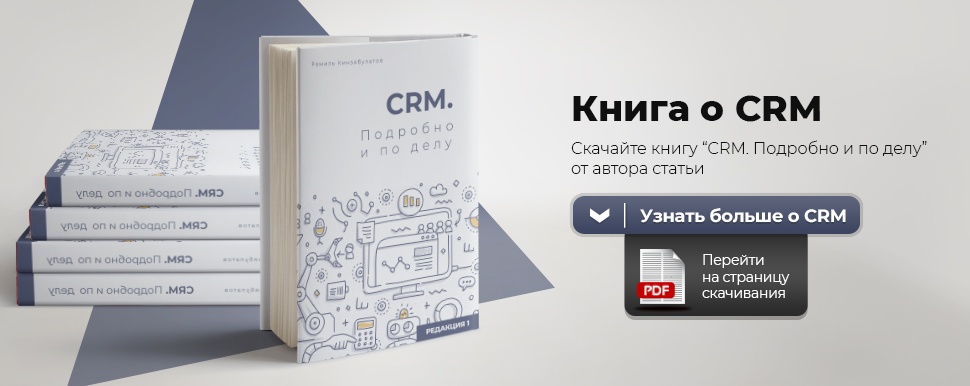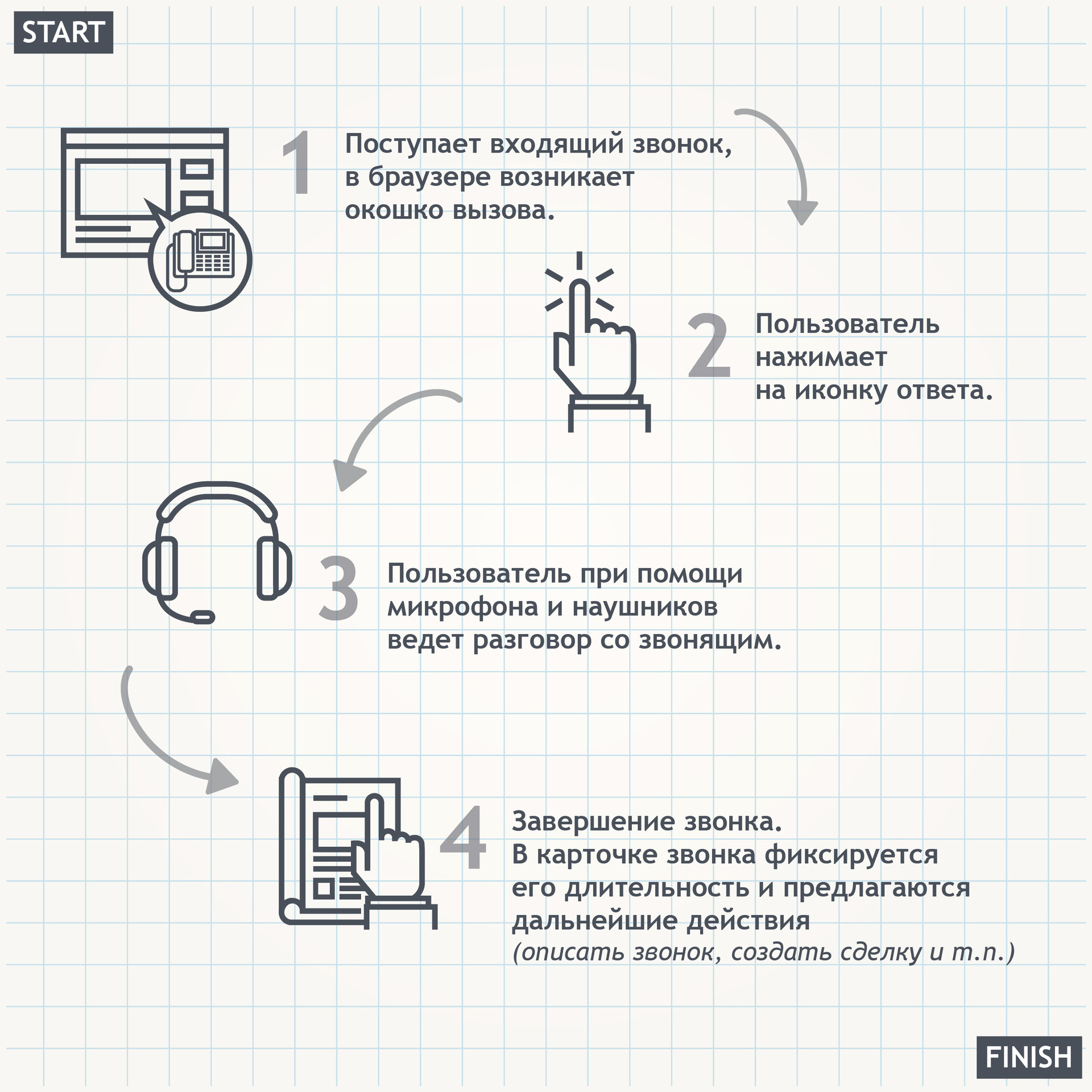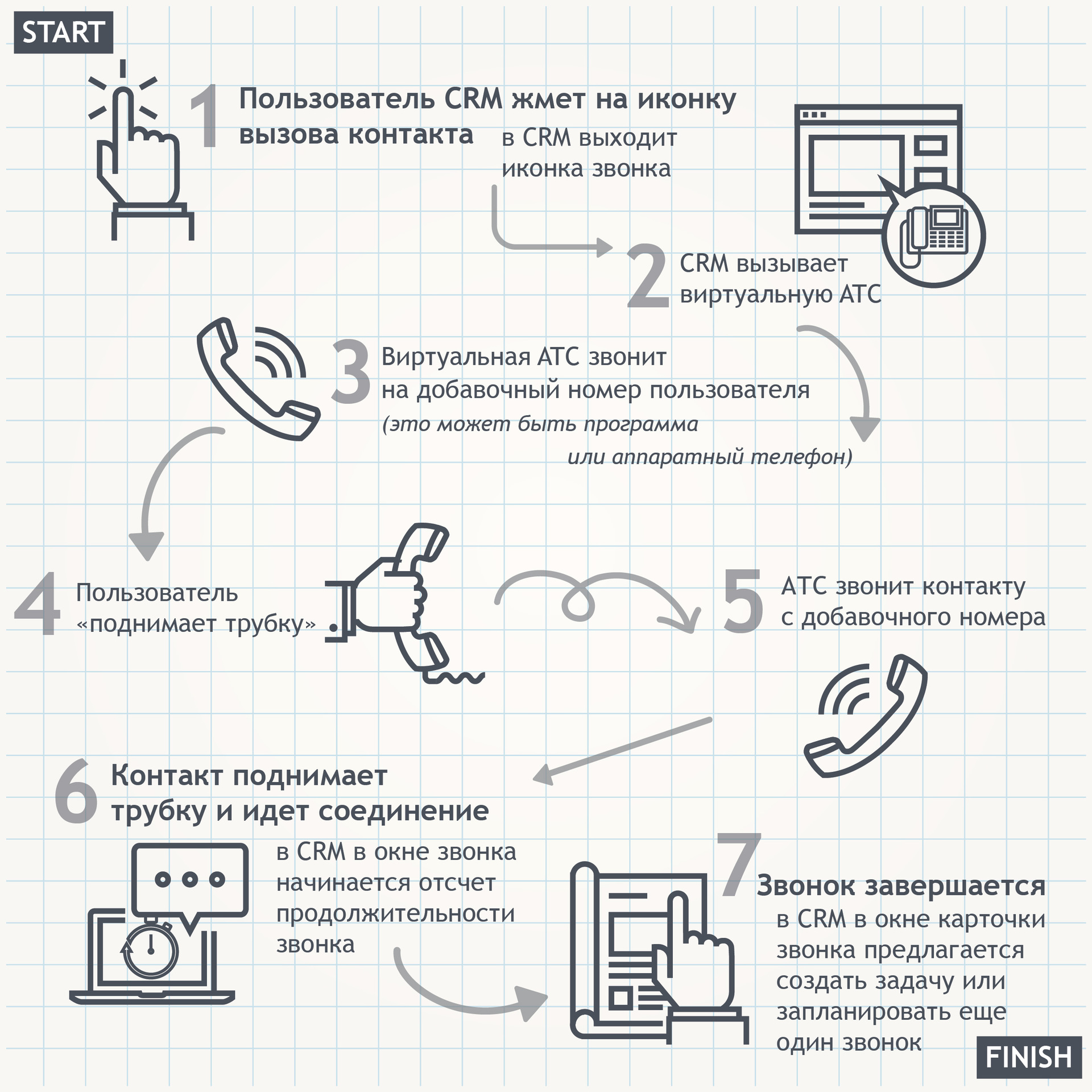What is telephony in CRM and how to choose it
Now it is almost impossible to imagine a CRM system without telephony. There are, of course, companies that do not use telephony in CRM, but now they are less and less.
I often have to explain to my clients how telephony works, what options exist in CRM, how they differ, what are the advantages and disadvantages of this or that option. I am constantly engaged in the integration of CRM and telephony and decided in this article to summarize my knowledge and share them.
This article should be considered as a continuation of one of my previously written articles “What is CRM-systems and how to choose them correctly?”
Through telephony, two-way communication is performed, the outgoing call is recorded directly from the CRM system and the call is received from the client in CRM. But the benefits of telephony in CRM are not limited to this. Telephony is not only a convenience: we call and receive calls in the CRM system without dialing a number or other unnecessary actions.
')
 Connected telephony is also one of the most important sources of sales department statistics. Knowing the duration of the call, the number of answered, unanswered calls, the number of incoming, outgoing calls for a certain period of time, you can find out how well one or another sales manager worked, how well he handled calls.
Connected telephony is also one of the most important sources of sales department statistics. Knowing the duration of the call, the number of answered, unanswered calls, the number of incoming, outgoing calls for a certain period of time, you can find out how well one or another sales manager worked, how well he handled calls.
For example, there are such reports as the ratio of the number of deals to the number of calls. On the basis of such reports one can understand how effective the employee is. Of course, if you have one manager, there’s nothing to compare with, but if you have two, three or more managers, you can understand from these factors which managers work better and make management decisions based on these data.
No matter what CRM you have: SAAS-system or Stand Alone (cloud or boxed solution), there are 2 types of telephony connection to CRM-systems:
The first type of connection is, of course, also SIP telephony, with the difference that there the SIP client is integrated into the web browser, and the conversation is carried out via a headset connected to the computer.
In the second case, we do not make a call from the browser, we initiate a call from the browser, and the direct answer to the call and conversation occurs either on a specialized telephone (the so-called VoIP phone) or in a SIP client, such as Zoiper, MicroSIP (many of them, I will not list all).
Let us analyze the first type of connection using a browser in more detail. With this type of connection, the telephony server is built into the CRM system itself.
That is, in order to contact the client, you need to connect to the browser and browser access to your devices: a microphone and headphones.
It is also necessary to understand that in this option the call rating is based on the tariffs of the CRM system or the system that is connected within the CRM. That is, you cannot choose SIP-telephony, the one that is convenient for you or which you like. You select a number only within the system, and the setting also takes place entirely within the system. Such significant functions as call forwarding and call recording are also dependent on the CRM system itself. Plug-ins or something else you can not connect.
Now let's dwell on the second type of connection using VoIP-telephony.
In this case, the connection does not depend on the CRM system itself. The user may not even suspect the presence of a CRM system (for example, an engineer or an accountant).
When choosing a particular telephony option, I usually cite the advantages and disadvantages of each type of connection to my clients as arguments. I quote them in this article:
Such options are ideal for small companies.
Now we note the advantages and disadvantages of telephony, not integrated with the CRM-system.
In principle, I don’t see any more minuses in this version of telephony.
This type of telephony, like SIP-telephony, is needed by companies with large sales departments.
I will describe one more very big difference between these two systems.
In telephony integrated in CRM, only a user registered in CRM can call. If you have one extension number, for example, a service department and accounting, and if you want to fully receive calls and make calls using this telephony, then all telephony users must be registered in the CRM system, including accountant. Otherwise it is impossible. It is impossible to keep one extensions on a virtual number, and other extensions - using telephony, built-in CRM-system.
So, if you have employees who are not registered in the CRM system, but who use the telephone, then you will have to either use another telephony or drag this user to the CRM system, which is not very good.
In the second case, using SIP-telephony, you can use part of the extension numbers to work in CRM, and part of the numbers can remain with non-CRM employees, an accountant or a warehouse worker, for example.
In the case of CRM-integrated telephony, there are no particular pitfalls. The only thing you should pay attention to is the compatibility of the browser with devices that receive and transmit sound.
In the case of SIP telephony, you can expect different situations:
It is necessary that there is no high ping between your IP-telephony and the CRM-system. I will explain why. On one project I had such a hitch. The CRM system was used foreign, and it was located somewhere on servers in Asia, and the telephony server was located in Northern Ireland. Accordingly, the ping was very large, and when the client called, the call card did not immediately appear in the system: for too long the signal went from the SIP server to the CRM system server. In order for the card to occur instantly, it is necessary that the PING be as small as possible.
Some companies use a VPN connection for security. That is, they go to the Internet via VPN, call from VPN. In such cases, it is necessary to take into account that the telephony server was also located inside the VPN.
Consider what costs are assumed when choosing telephony.
If with the first option of CRM integrated telephony everything is clear: we look at the rates in the browser and connect the phone number - then when choosing the second type of connection, you must immediately understand that:
I often get asked this question. For example, if employees are traveling and need to make calls from cell phones? I’ll say right away that now it’s impossible now, because the cell phone numbers are not fixed, although one mobile operator in Russia has the option of recording the corporate number as a SIP number (you are calling to a mobile, but a SIP program card is being opened).
But for this it is necessary that the information be transmitted not from a mobile handset, but from a virtual PBX, to which no access is given.
It does not matter. Ask your provider if it is possible to integrate their telephony system with your CRM. For example, I had a project where a special software adapter was made for the company, which connected the telephony of the provider and the customer's CRM. The provider of the big three, and the integration of any problems have arisen.
I hope I have explained in an accessible way what types of telephony exist in the CRM system, what you should pay attention to when choosing what costs implies the introduction of a particular telephony.
I often have to explain to my clients how telephony works, what options exist in CRM, how they differ, what are the advantages and disadvantages of this or that option. I am constantly engaged in the integration of CRM and telephony and decided in this article to summarize my knowledge and share them.
This article should be considered as a continuation of one of my previously written articles “What is CRM-systems and how to choose them correctly?”
What is telephony in CRM.
Through telephony, two-way communication is performed, the outgoing call is recorded directly from the CRM system and the call is received from the client in CRM. But the benefits of telephony in CRM are not limited to this. Telephony is not only a convenience: we call and receive calls in the CRM system without dialing a number or other unnecessary actions.
')
 Connected telephony is also one of the most important sources of sales department statistics. Knowing the duration of the call, the number of answered, unanswered calls, the number of incoming, outgoing calls for a certain period of time, you can find out how well one or another sales manager worked, how well he handled calls.
Connected telephony is also one of the most important sources of sales department statistics. Knowing the duration of the call, the number of answered, unanswered calls, the number of incoming, outgoing calls for a certain period of time, you can find out how well one or another sales manager worked, how well he handled calls.For example, there are such reports as the ratio of the number of deals to the number of calls. On the basis of such reports one can understand how effective the employee is. Of course, if you have one manager, there’s nothing to compare with, but if you have two, three or more managers, you can understand from these factors which managers work better and make management decisions based on these data.
What types of telephony are offered in CRM systems.
No matter what CRM you have: SAAS-system or Stand Alone (cloud or boxed solution), there are 2 types of telephony connection to CRM-systems:
- CRM integrated telephony
- SIP telephony.
The first type of connection is, of course, also SIP telephony, with the difference that there the SIP client is integrated into the web browser, and the conversation is carried out via a headset connected to the computer.
In the second case, we do not make a call from the browser, we initiate a call from the browser, and the direct answer to the call and conversation occurs either on a specialized telephone (the so-called VoIP phone) or in a SIP client, such as Zoiper, MicroSIP (many of them, I will not list all).
Telephony integrated into CRM.
Let us analyze the first type of connection using a browser in more detail. With this type of connection, the telephony server is built into the CRM system itself.
Consider how a call is made using this type of connection:

- The user connects to the system and selects a customer card.
- The user clicks on the customer icon on the call icon.
- A call and conversation with a client using headphones and a microphone occurs.
- End the call. The call card records its duration and suggests further actions (describe the call, create a deal, etc.)
The procedure for receiving a call is similar to:

- An incoming call arrives, a call window appears in the browser.
- The user clicks on the answer icon.
- The user uses a microphone and headphones to talk with the caller.
- End the call. The call card records its duration and suggests further actions (describe the call, create a deal, etc.)
That is, in order to contact the client, you need to connect to the browser and browser access to your devices: a microphone and headphones.
It is also necessary to understand that in this option the call rating is based on the tariffs of the CRM system or the system that is connected within the CRM. That is, you cannot choose SIP-telephony, the one that is convenient for you or which you like. You select a number only within the system, and the setting also takes place entirely within the system. Such significant functions as call forwarding and call recording are also dependent on the CRM system itself. Plug-ins or something else you can not connect.
SIP telephony.
Now let's dwell on the second type of connection using VoIP-telephony.
How is the call in this case?

- CRM user clicks on the icon to call the contact. In CRM there is a call icon.
- CRM calls virtual ATC.
- Virtual ATC calls to the user's extension number (this can be a program or a hardware phone).
- The user “picks up the phone”.
- A PBX calls the contact from the extension.
- The contact picks up the phone and a connection is in progress. In CRM, the duration of the call begins in the call window.
- The call ends. In CRM, the duration of the call is recorded in the call card. As a rule, after the end of the call in the window of the call card you are asked to create a task, describe the call or schedule another call.
The scheme of an incoming call with this connection option is as follows:

- The customer calls the landline number, then dials the extension, or the secretary transfers the customer to the extension number.
- A call window appears in the CRM system, which shows information about who is calling (if the contact is in the database) and other information depending on how the CRM system is configured. The user “picks up the phone” (in the program or on the phone). In CRM, the call begins.
- There is a conversation with the client.
- End the conversation. In CRM, the duration of the call is recorded in the call card. If the system already has a contact who called, the reason for the call, its description and other information is recorded. If the contact is not defined by the system, it is proposed to create it, and with it to create, for example, a deal, if there is a need for it, everything depends on the system settings.
In this case, the connection does not depend on the CRM system itself. The user may not even suspect the presence of a CRM system (for example, an engineer or an accountant).
Advantages and disadvantages.
When choosing a particular telephony option, I usually cite the advantages and disadvantages of each type of connection to my clients as arguments. I quote them in this article:
“Cons” CRM-integrated telephony:
- Dependence on the browser and devices. If you have something wrong with the browser settings or with a headset, then you can not call or take a call.
- In CRM-systems, a very limited functionality, it can not be compared with the same Asterisk. Here such functions as call recording, call forwarding, especially complicated call forwarding, are impossible if we want to forward a call not only to an internal subscriber, but to someone else.
- Dependence of tariffs on CRM-telephony. You can not choose something else, you use what offers you a CRM-system.
- You can not connect an existing phone number. For example, if you already have a SIP number, you will not be able to connect it. You will have to connect the new number offered by CRM itself.
- With this type of telephony, you are tied to the workplace, to the headset, you definitely need a computer and access to CRM.
“Pluses” of CRM-integrated telephony:
- The connection is direct, that is, the connection occurs immediately and is a more familiar call pattern.
- Quick connect. In this case, you do not need to configure a virtual PBX. Simply register the number and extensions, and you can safely make outgoing and receive incoming calls.
Such options are ideal for small companies.
Now we note the advantages and disadvantages of telephony, not integrated with the CRM-system.
“Cons” SIP-telephony:
- The need for customization, the relative complexity of customization. You need to configure a virtual telephony server, you need to configure each handset or device, you must set passwords, and so on.
- The relative high cost. This connection option is more expensive than the first one, since it is necessary for it to buy IP telephony devices or a program. Many are afraid that it is necessary to raise the server and pay for it. But we must understand that in addition to the acquisition cost, there is a cost of ownership, and in the case of non-integrated telephony, it is less, since there is a choice of tariffs.
- The content of the infrastructure. I must say that this item does not imply large costs. For the same Asterisk - the minimum server and, in principle, everything, it works and does not require special maintenance.
In principle, I don’t see any more minuses in this version of telephony.
“Pluses” of SIP telephony:
- Huge selection of telephony (equipment for every taste and color is on the market)
- Independence from the browser and CRM system. The CRM system here acts as another consumer of information from IP-telephony, but in no way is it a source for calls, for IP-telephony. Independence from the CRM system, I think the most important advantage.
- The possibility of choosing a provider. You can choose the provider through which you want to work, you can choose the rate that suits you. Some users of this type of telephony make calls to different numbers from different providers, depending on which of the providers is cheaper.
- Extensive telephony configuration options. You can set up call forwarding, call for certain conditions, recording, Voice Mail, various codecs.
This type of telephony, like SIP-telephony, is needed by companies with large sales departments.
I will describe one more very big difference between these two systems.
In telephony integrated in CRM, only a user registered in CRM can call. If you have one extension number, for example, a service department and accounting, and if you want to fully receive calls and make calls using this telephony, then all telephony users must be registered in the CRM system, including accountant. Otherwise it is impossible. It is impossible to keep one extensions on a virtual number, and other extensions - using telephony, built-in CRM-system.
So, if you have employees who are not registered in the CRM system, but who use the telephone, then you will have to either use another telephony or drag this user to the CRM system, which is not very good.
In the second case, using SIP-telephony, you can use part of the extension numbers to work in CRM, and part of the numbers can remain with non-CRM employees, an accountant or a warehouse worker, for example.
What pitfalls await you in implementing this or that approach.
In the case of CRM-integrated telephony, there are no particular pitfalls. The only thing you should pay attention to is the compatibility of the browser with devices that receive and transmit sound.
In the case of SIP telephony, you can expect different situations:
It is necessary that there is no high ping between your IP-telephony and the CRM-system. I will explain why. On one project I had such a hitch. The CRM system was used foreign, and it was located somewhere on servers in Asia, and the telephony server was located in Northern Ireland. Accordingly, the ping was very large, and when the client called, the call card did not immediately appear in the system: for too long the signal went from the SIP server to the CRM system server. In order for the card to occur instantly, it is necessary that the PING be as small as possible.
Some companies use a VPN connection for security. That is, they go to the Internet via VPN, call from VPN. In such cases, it is necessary to take into account that the telephony server was also located inside the VPN.
The cost of implementing telephony.
Consider what costs are assumed when choosing telephony.
If with the first option of CRM integrated telephony everything is clear: we look at the rates in the browser and connect the phone number - then when choosing the second type of connection, you must immediately understand that:
- it is necessary to rent a VDS server through which traffic will flow and on which a virtual PBX will be installed;
- you must select a provider and phone number to connect the phone number to the virtual PBX server;
- costs of setting up the server itself are assumed - it will be necessary to set up extensions, forwarding, configure the telephones themselves to work with VoIP telephony;
- the costs of maintaining telephony are possible - these are not very big expenses, if you fix it once, then you will simply use the resources and that's it.
Other matters.
What if employees answer calls via cell phones?
I often get asked this question. For example, if employees are traveling and need to make calls from cell phones? I’ll say right away that now it’s impossible now, because the cell phone numbers are not fixed, although one mobile operator in Russia has the option of recording the corporate number as a SIP number (you are calling to a mobile, but a SIP program card is being opened).
But for this it is necessary that the information be transmitted not from a mobile handset, but from a virtual PBX, to which no access is given.
What if I use a corporate phone, and there is no ready-made solution for integration with CRM?
It does not matter. Ask your provider if it is possible to integrate their telephony system with your CRM. For example, I had a project where a special software adapter was made for the company, which connected the telephony of the provider and the customer's CRM. The provider of the big three, and the integration of any problems have arisen.
I hope I have explained in an accessible way what types of telephony exist in the CRM system, what you should pay attention to when choosing what costs implies the introduction of a particular telephony.
Source: https://habr.com/ru/post/295118/
All Articles
